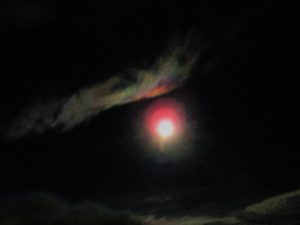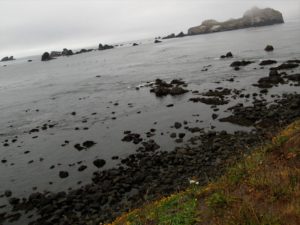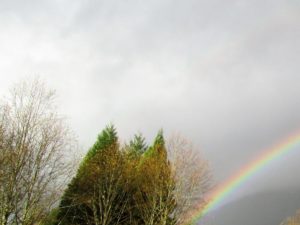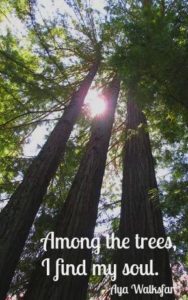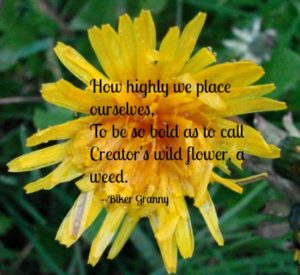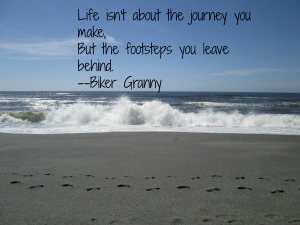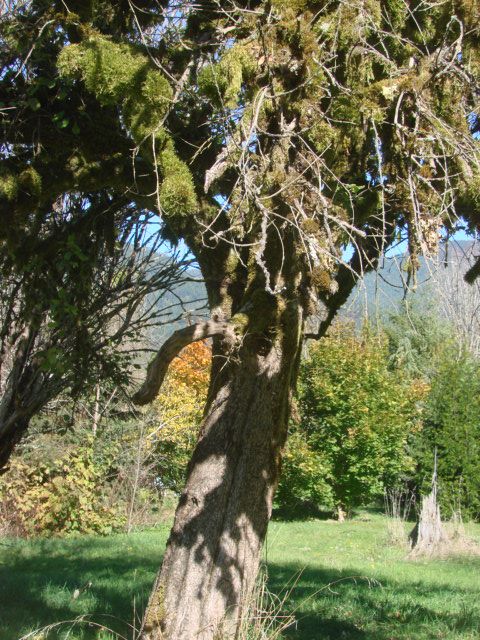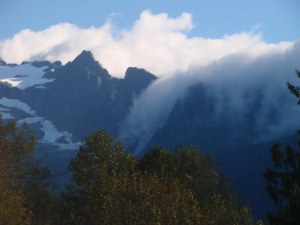 White Horse Mountain, Cascade Mountains, Darrington, Washington
White Horse Mountain, Cascade Mountains, Darrington, Washington
Lessons Learned (The Observations of a Wildlife Habitat Manager)
Other than #author, I have several hats that I wear. Among them is the Wildlife Habitat Manager Hat. Habitat is NOT a sanctuary. It is a place where wildlife and wild birds can arrive and depart as they please. Habitat offers the wild ones food (in the form of plants, trees and the resultant insects), water (sometimes in the form of water dishes if the natural water source dries up), and shelter/nesting areas (in the form of bushes, trees, tall grass areas, undergrowth and deliberately maintained ‘slash piles’ of natural plants including tree limbs), and, hopefully, a measure of safety from domestic predators such as cats and dogs.
In 1996, my wife and I bought twelve acres of abused farmland. When I label the land abused what I mean is that the fields had been overgrazed, invasive weeds such as non-native blackberry bushes and morning glories had taken over approximately eleven acres of the land, garbage had been dumped on the creek banks and piled in a variety of other places (all of which we discovered as we took down the invasive blackberry brambles); old cars, farm equipment, freezers–complete with the rotted carcasses and hides of deer, bear and other wildlife– and other appliances also hid beneath the blackberry brambles; and, sadly, we also uncovered the skeletons and other remains of animals and birds killed for the sake of killing and left to rot where they lay.
When we first moved here, no birds flew over the property. It reminded me of the silent spring that Rachel Carson evoked with the title of her important book. Not until our medicine man came and blessed the land did the birds return. The first bird in was the tiny Rufous Hummingbird.
Since that time, we have cataloged sixty-eight different species of birds who visit our land, usually staying to shelter and/or nest. We have had a variety of wildlife, including a family of deer who frequently have their fawns in our back field and coyotes who sing their mournful songs to the dark of night.
But, the journey has not been without it setbacks and detours. So here are a few of the lessons learned by this wildlife habitat manager:
—When calculating the amount of time a rehab project might take, add in one-half again of what you think (ie: 40 hours would become 60 hours). This will allow for delays, surprises and just days when you want to play instead of work.
—Be aggressive with invasive plants! Whether the plants are Euro-Asian blackberries, morning glories, scotch broom or English daisies, begin a program of spray-mow-spray immediately. For the sake of the wild ones, try to use eco-friendly herbicides such as Round-Up. It you really need more toxic herbicides, such as some of the caustics, try to spot spray and limit the amount of the chemical used as well as the amount of land it is applied to.
—Not everything the experts tell you to try will work. For several winters, I fought a losing battle with snow tearing the gutters off of the barn. We tried a number of different remedies, including snowjacks that are in use in places like Alaska. The problem with our snow is that it accumulates, partially melts, refreezes and accumulates some more making most types of snowjacks not very efficient and often the victim of the snow pack along with the gutters. The way we resolved our issue was with four foot deep trenches around our barn under the roofline. We filled the trenches with two different sizes of rock/gravel and with French drain then created a ditch that leads to a depression where the water can slowly dissipate. It works, for us. Don’t be afraid to try out your own ideas.
—Try different plants in different areas! You may be surprised that what will grow in one place, won’t flourish in another place that appears to be the exact same type of ground, sunlight and moisture.
—When visiting nurseries, ignore most of the statements like “Oh, no, this is not invasive”; “no, you won’t have any problem with this spreading where you don’t want it” and similar statements. Many of the current invasives that we battle daily were brought here deliberately by other people, including the scourges of farmland and wildlife habitat–English daisies and scotch broom! No one thought these “pretty flowers” would become noxious weeds. We can eradicate invasive plants. Be consistent and persistent!
Try to use plants that are native/indigenous to your area. (Our neighbor planted a black walnut tree and now we have bunches of baby black walnut trees sprouting up everywhere). Think twice about eradicating what your neighbors may term ‘weeds’ if that plant is indigenous, such as salmonberry bushes and Indian plum bushes. Many times the wildlife/wild birds that are native to your area really need these plants (sometimes, the very ones your neighbors labor weeds)! Both salmonberry and Indian plum are early spring flowering plants that provide much needed nectar for the hummingbirds who arrive before other trees and bushes set their blossoms.
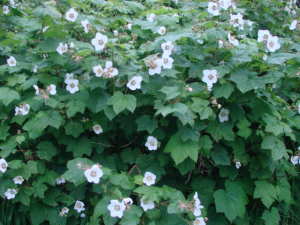 Patch of Thimbleberry bushes (Pacific Northwest native plant; edible by humans, birds and wildlife. A tasty red berry on a thornless bramble.)
Patch of Thimbleberry bushes (Pacific Northwest native plant; edible by humans, birds and wildlife. A tasty red berry on a thornless bramble.)
Salmonberry bushes are much more sensitive (especially to herbicides) than many people believe and can be controlled (kept to one area) by mowing the young starts that sprout through rhizome propagation. As well as providing nectar, these delicate blossoms are a lovely relief from the barrenness of winter. According to my adoptive mother, Vi taqseblu Hilbert, who was an Upper Skagit elder, new shoots were once eaten by #NativeAmericans much like asparagus. The berries are red or gold colored and delicious for people, birds or other wildlife.  Salmonberry blossom (Pacific Northwest native plant)
Salmonberry blossom (Pacific Northwest native plant)
—Be gentle with yourself! This was a very important lesson for me. I tend to demand not only perfection of myself, but perfection as of yesterday! No matter how dedicated and hardworking you are, take time to stop and just walk the land, enjoy all that you have accomplished. Be sure to take ‘before’ photos you can refer to because many times we don’t see the progress we are making. Sort of like being in a dense forest–rather difficult to see the whole tree.
—Remember, even though one person can’t save the entire planet; we can’t even save the entire species–whatever the species–we can make a difference one person at a time; one small piece of land at a time. So, whether you have a small backyard or a hundred acres, what you do matters. When you provide food, water and shelter for two birds that gives that bird species one more place to rest, to eat and grow strong, and to bring young into this world to bless all of us. And, each time one of us provides habitat for the wild ones, we demonstrate to our neighbors and friends that it can be done without sacrificing the use and enjoyment of our property. We can make a difference; and, we can make this world a tiny bit better for us having been here.
We are saving, preserving and increasing beauty each day.
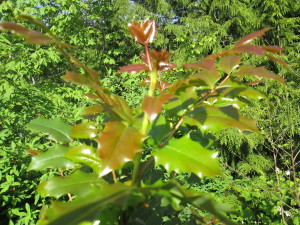 Oregon Grape (Pacific Northwest native plant; berries are edible by humans, birds and wildlife)
Oregon Grape (Pacific Northwest native plant; berries are edible by humans, birds and wildlife)
To see photos of the author’s land, go to Pinterest (http://www.pinterest.com/ayawalksfar) and view Jaz Wheeler’s farm. My character in Run or Die has much the same kind of place as we do. Funny how that works!
